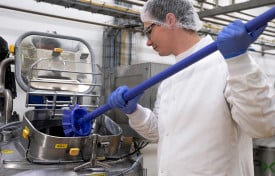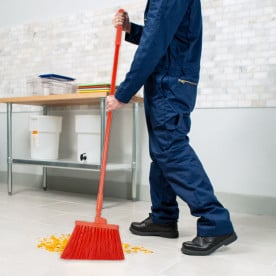cleaning

- September 30, 2024
Our line of Sani-Safe® knives offers the weight and balance of wood-handled knives with the sanitary advantage of polypropylene.
To maximize the performance of Sani-Safe Cutlery, we recommend adhering to the following guidelines.
- Cutlery should be hand washed in mild to medium strength detergent and towel-dried.
- Knives should NOT be placed in automatic dishwashers. The blade edges will be dulled from rubbing against each other, and caustic detergents will cause staining and pitting of the blade.
- Cutlery should NOT be soaked for long periods or submerged for cleaning. If cutlery is soaked in soap, bleach, or chlorine, the soaking should be kept to a minimum, the products rinsed thoroughly, and dried immediately.
- Chlorine and bleach discolor and pit stain-free and high-carbon steel. If chlorine or bleach products come in contact with the blade, they must be thoroughly rinsed off immediately.
- When cutlery is left
- April 07, 2021
Ah, the beauty and purity of a new cleaning tool. Freshly removed from any packaging, and unsullied by the elements: nothing but possibility ahead of it. Whether you enjoy opening new tools as much as I apparently do, or you are more in the “pop it open, because there is a ton of stuff to do” camp, there are a few tips that our friends from Remco have provided to get the best out of your new cleaning tool. These simple steps help to ensure safety before the first use.
How to Prepare a New Cleaning Tool for Use
New cleaning tools—especially those sealed in plastic pouches like the ones from Vikan® and Remco—often look like they’re ready for use right out - March 31, 2021
Springtime brings many new colors, from the flowers popping up in gardens to the spring and summer produce offerings at the grocery store. During this colorful time of year, it might be the perfect opportunity to take a look at color-coding in your facility, whether that means starting a new color-coded program or expanding an existing program.
Nelson-Jameson has expanded our color-coded program once again with the release of our 2021 Color-Coded Catalog. This year's catalog has grown to 68 pages of products that are designed to help prevent allergen migration and cross-contamination. A complete color-coded program helps to lay the foundation for a solid food safety program, and can help minimize the risk of cross-contamination.
Why choose a color-coded system? A complete color-coded system helps promote organization and efficient workflow. Designating critical control areas and zones helps your sanitation program by ensuring that the tools stay in the areas in
- November 09, 2020
According to the FDA, "one of the most commonly documented food safety problems in plants have involved sanitation monitoring, including checking food-contact surfaces and plant cleanliness" (Schug, para. 1). To make matters even more complicated, the
COVID-19 pandemic disrupted normal operations as well for countless food and beverage manufacturers. Disruptions may occur due to limited staff because of layoffs, social distancing requirements, or sickness. These situations on top of the normal expectations of having a clean food plant, can lead to the need of resources for food safety sanitation.It is essential that food manufacturers create safe, quality food, therefore, routine practices need to continue, and additional sanitation protocols may need to be added. Employers also need to ensure a safe environment for their staff, including minimizing the risk of being exposed
- October 30, 2020
Significantly minimize food vulnerabilities with Nelson-Jameson's food defense product solutions! According to the FDA, food defense is defined as, "the effort to protect food from acts of intentional adulteration" (Food Defense, 2020, para. 1). Intentional adulteration could include various contaminations that are intended to cause harm to the public. In order to prevent and protect from harmful contamination, a food defense plan needs to be established. A food defense plan first consists of your facility completing a vulnerability assessment. This assessment is to determine where in the facility's processes pose the greatest risk for contamination. Second, mitigation strategies need to be selected for identified vulnerabilities, and lastly, corrective action needs to be implemented. Nelson-Jameson has products that are designed to assist with mitigation and preventative strategies within your facility and aid in your food defense plan:
• Use color-coded personnel identification
- July 20, 2020
Have you ever missed one or two of your normal tooth-brushing sessions, and found your tongue traversing over a disconcertingly slimy layer coating your chompers? Well, welcome to the disturbing and quite fascinating world of biofilms. These hearty amalgams of microbiological activity provide both protection for microorganisms, as well as headaches for not only those avoiding plaque build-up, but most importantly for this blog, the food industry (allowing harborage and protection for bacteria and fungi).
Biofilms can form on a variety of surfaces in food processing environments, including stainless steel. A supercell of harborage, “Biofilms are complex microbial ecosystems formed by one or more species immersed in an extracellular matrix of different compositions depending on the type of food manufacturing environment and the colonizing species” (Geaile, et al). The
- April 16, 2018
With constant eyes on profit margins, processors strive to make every dollar count on the processing line. Are you trying to figure out your next continuous improvement project aimed at maximizing profits for your operations? Turbidity monitoring from Anderson-Negele can help to maximize profits while saving money on wasted product going down the drain during cleaning cycles.
Turbidity is defined as, "the phenomenon where by a specific portion of a light beam passing through a specific liquid medium is reflected by undissolved particles." Basically, the sensor acts like a flashlight into the light stream and senses the light that comes
- August 30, 2013
Steam: this is not really a topic most would like to think about as the temperature climbs. However, it is a topic you may want to take note of though for the next few moments, as it could affect your bottom line this summer and beyond. Steam cleaning is a powerful method used to combat germs and to sanitize surfaces in domestic, commercial, and industrial spaces. This summer, Nelson-Jameson is offering some one-time-only deals on steam cleaners.
For food operations, there are several key aspects of steam cleaning that are ideal for industrial settings. First, steam cleaning is effective; it kills germs and bacteria. It also attacks grease and cleans surfaces thoroughly. Second, it is cost-effective. Using steam means less chemicals in your plant and it means merely adding water to your steam cleaner to effectively get the job done. Third, the right steam cleaner can reduce your manual labor costs.
If you would like to know more about steam cleaners for your operation and






